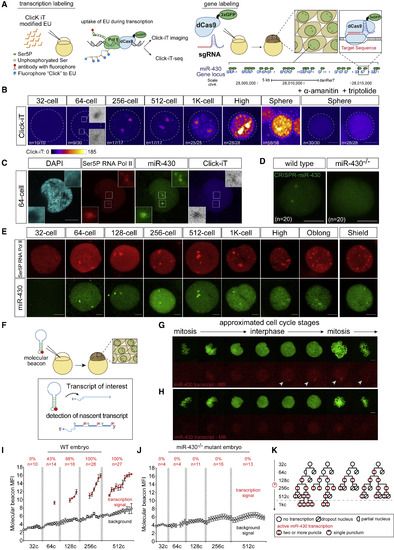Fig. 1
- ID
- ZDB-FIG-190820-25
- Publication
- Chan et al., 2019 - Brd4 and P300 Confer Transcriptional Competency during Zygotic Genome Activation
- Other Figures
- All Figure Page
- Back to All Figure Page
|
Zygotic Genome Activation Begins with the miR-430 Locus in a Gradual and Stochastic Manner (A) Schematic illustrating strategies used to visualize global transcription using Click-iT chemistry (left) and the miR-430 locus using CRISPR-dCas9-3xGFP (dCas9) (right). (B) Time-course imaging analysis of Click-iT-labeled zygotic transcription from 32-cell (∼1.75 hpf) to sphere stage (∼4 hpf). Representative nucleus from embryos treated with transcription inhibitors (α-amanitin and triptolide) is shown as negative control. Scale bar represents 5 μm. Nucleus is outlined using DAPI signal by a dotted line (n = the fraction of analyzed nuclei that shows the same transcriptional output as the representative nucleus). (C) Representative single-nucleus confocal images labeled with DAPI, phosphorylated Ser5 RNA Pol II (Ser5P RNA Pol II), miR-430 loci, and Click-iT (transcription). Scale bar represents 5 μm. Insets represent single-plane images of individual foci showing colocalized signal. (D) CRISPR-dCas9 labeling reveals two foci signals in wild-type (WT) embryos but not in miR-430−/− mutants that lack the miR-430 locus, demonstrating the signal specificity toward the miR-430 endogenous locus (n = number of analyzed nuclei across three embryos). Scale bar represents 5 μm. (E) Time-course analysis of single nuclei labeled for Ser5P RNA Pol II and dCas9 targeting the miR-430 locus from 32 cells to shield stage. Scale bar represents 5 μm. (F) Schematic illustrating in vivo labeling of nascent transcript of miR-430 in zebrafish embryos for live imaging using a molecular beacon (MBmiR430). (G and H) miR-430 transcription in vivo visualized by MBmiR430 during 128-cell-stage cell cycle in WT (G) or miR-430−/− mutant (H). Chromatin is labeled with Alexa Fluor 488 histone H1. Scale bar represents 5 μm. The approximated stage of the cell cycle is inferred by level of condensation of the chromatin and the shape of the nucleus as labeled by the Alexa Fluor 488 histone H1. MBmiR430 signals are highlighted by white arrows in the confocal images. miR-430 transcription is only detected in late interphase and early prophase (mitosis). Note the absence of MBmiR430 signal in miR-430−/− mutants. (I and J) MBmiR430 mean fluorescence intensity (MFI) quantified over each cell cycle in wild-type embryos (I) and miR-430−/− mutant embryos (J). Red dots represent the time points when MBmiR430 signal is detected; gray dots represent the nuclear background MBmiR430 signal (n = number of nuclei imaged; percentage represents the proportion of analyzed nuclei that display miR-430 transcription). (K) Representative cell-lineage tracing for miR-430 transcription. Transcription competency is acquired in a stochastic manner at 64-cell, and once gained is maintained in the daughter cells after cell division. |
Reprinted from Developmental Cell, 49, Chan, S.H., Tang, Y., Miao, L., Darwich-Codore, H., Vejnar, C.E., Beaudoin, J.D., Musaev, D., Fernandez, J.P., Benitez, M.D.J., Bazzini, A.A., Moreno-Mateos, M.A., Giraldez, A.J., Brd4 and P300 Confer Transcriptional Competency during Zygotic Genome Activation, 867-881.e8, Copyright (2019) with permission from Elsevier. Full text @ Dev. Cell

